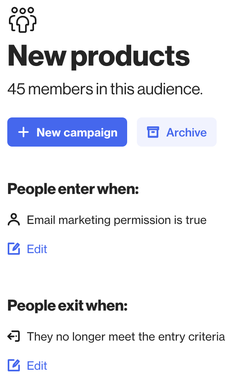Understand and manage people’s subscription preferences
Overview
When adding people (contacts) to your CDP it is important to remember that people, unless created as an unsubscribed record via a data source or via the appropriate API call, are subscribed by default. For example, importing a person via a spreadsheet (CSV file) containing their name, email address and phone number (with no permission mapping) will mean that the person is automatically subscribed to email and SMS, and is placed in default audiences such as Subscribers and SMS subscribers.
Some data source integrations can only send Ortto a person’s subscription permission; a change of permission cannot be sent from Ortto to the data source. This is the case for Shopify, for example, where a person’s subscription permissions reflect their permissions in Shopify. Permission settings for new and existing customers will only be updated if the permission change comes from Shopify.
Learn more about managing subscription permissions using an API call in Configuring people’s subscription permissions.
Audiences
You can create different audiences based on people who have opted in to receive email communications.

When creating your audiences, it’s a good idea to organize these based on the types of communications you wish to send. For example, you might create an audience named "Product" for communicating with subscribers about product releases and updates. This will also help your audience members understand and decide which communications they wish to receive, if you add the audiences to the email and SMS preference centers.
NOTE: If you choose to create a new audience to replace an existing audience (rather than editing the existing audience settings) you will need to ensure that people who are members of the new audience are added respective of their subscription preferences in the original audience.
Learn more about creating audiences in Creating a new audience.
Unsubscribed people
When a person is unsubscribed, they can be added to a journey or playbook but will not qualify to receive any email or SMS messages.
The only exception is with transactional messages, where:
- people who are unsubscribed from email can still receive transactional messages, but
- people who are opted-out of SMS cannot receive transactional messages.
Learn more about transactional messages in making campaign messages transactional.
In playbooks and journeys, depending on the entry criteria, people may qualify for (enter) the campaign even though they aren’t subscribed (such as if you use entry conditions unrelated to audience membership). You can set up your campaign to ensure that only subscribers of a particular audience receive the campaign messages:
- Journeys — In the journey details panel, under Audience, select To subscribers of a specific audience and a relevant audience.
- Playbooks — In the playbook details panel, under Send messages, select To subscribers of a specific audience and a relevant audience.
Learn more about creating journey and playbook campaigns in Creating a journey campaign and Playbook campaigns.
Extract subscription changes
When you export your CDP data, audience membership is not included.
As such, if you wish to store audience subscription preferences in your own external database you will need to create a webhook that is triggered based on an Unsubscribed from <audience name> audience activity.
Learn more about creating a webhook in Configuring a webhook.
Archive people
Archiving a person soft deletes them from your main people list. It is important to heed the following warning about archiving people, in relation to subscription preferences.
WARNING: Exercise caution when archiving people, since doing so puts them in a state where they are no longer tracked or recognized.
If Ortto receives an activity involving an archived person from a data source (which is configured to add unknown people by default) then a duplicate contact/person record will be created for this person in your CDP.
The duplicate person will not retain the person’s original subscription status (unless created as an unsubscribed record via a data source or via the appropriate API call), as the duplicate is treated as a new record. Similarly, should you re-add people you have archived, you will need to verify their subscription status before they are added back.
Learn more about archiving and restoring people under Archive people in Managing people.
